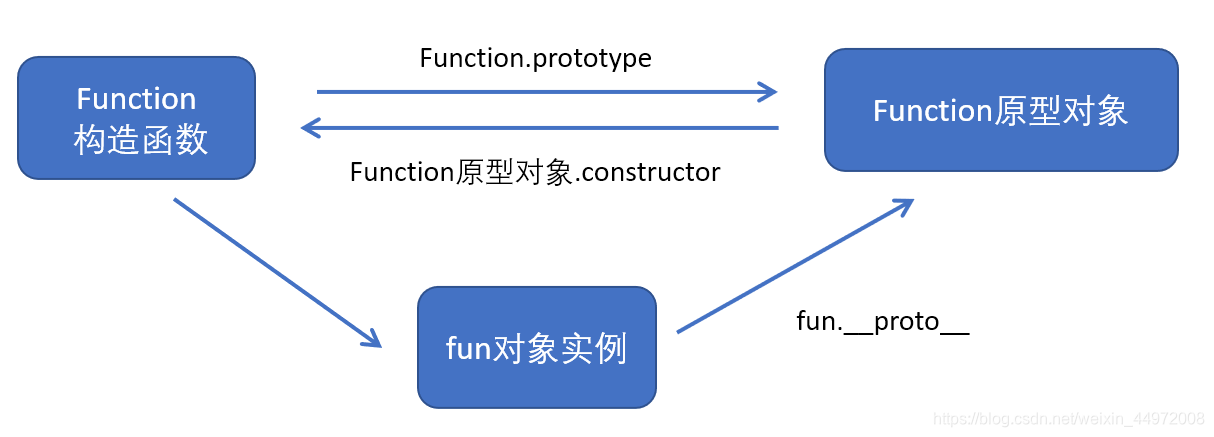【JS】函数定义与调用方式-函数this指向问题-call-apply-bind方法使用与自定义
本文共 3712 字,大约阅读时间需要 12 分钟。
文章目录
1. 函数定义的几种方式
1.1 函数声明式
function fn(a, b) { return a + b;} 1.2 函数表达式
let fun = function(a, b){ return a + b;} 1.3 构造函数式
let fun = new Function('a', 'b', 'return a + b') 1.4 箭头函数
let fn = (a, b) => { return a + b;}; 关于箭头函数的更多内容,
1.5 注意点
所有函数都是 Function 的实例对象, 属于对象 instanceof Object

2. 函数调用的几种方式
2.1 普通函数
fun()fun.call()
2.2 对象的方法
obj.fun()
2.3 构造函数
new Fun()
2.4 绑定事件函数
触发事件调用
btn.onclick = function(){ }; // 点击按钮调用 2.5 定时器函数
定时器到达指定时间自动调用
setInterval(function(){ }, 1000) // 定时器自动一秒钟调用一次 2.6 立即执行函数
自动自己调用
(function(){ })() 3. 函数中this指向
根据调用方式不同,this的指向也不同,一般指向调用者
具体总结表格如下所示
| 调用方式 | this指向 |
|---|---|
| 普通函数调用 | window |
| 构造函数调用 | 实例对象, 原型对象里面的方法也指向实例对象 |
| 对象方法调用 | 该方法所属对象 |
| 事件绑定方法 | 绑定事件对象 |
| 定时器函数 | window |
| 立即执行函数 | window |
- 注意 在箭头函数中,
this是静态的,this始终指向函数声明时所在作用域下的this的值 关于箭头函数的更多内容,
4. 改变函数的this指向
4.1 使用call方法
fun.call(thisArg, arg1, arg2, ...)
作用:1. 调用函数 2. 改变函数this指向
function add(a, b) { console.log(a + b)}let obj = { c: 520}add(1,2) // this指向windowadd.call(obj, 1, 2) // this指向obj 应用
主要的作用是可以实现继承
function Father(uname, age, sex) { this.uname = uname this.age = age this.sex = sex}function Son(uname, age, sex){ Father.call(this, uname, age, sex)}let son = new Son('YK菌', 18, '男')console.log(son) // Son {uname: "YK菌", age: 18, sex: "男"} 4.2 使用apply方法
fun.apply(thisArg, [argsArray])
作用:1. 调用函数 2. 改变函数this指向
但是他的参数必须是数组(伪数组)function add(a, b) { console.log(a + b)}let obj = { c: 520}add(1,2) // this指向windowadd.call(obj, [1, 2]) // this指向obj 应用
可以利用apply 借助数学内置对象求最大值
let arr = [1, 34, 556, 44, 23]Math.max.apply(null, arr); // null 表示不需要改变this指向Math.max.apply(Math, arr); // 不改变的话最好就指回去
4.3 使用bind方法
fun.bind(thisArg, arg1, arg2, ...)
不会调用函数,但是可以改变函数内部this的指向
返回 由指定的this 值和初始化参数改造的原函数拷贝 function add(a, b) { console.log(a + b)}let obj = { c: 520}add(1,2) // this指向windowlet f = add.bind(obj, 1, 2) // this指向obj, 不会调用f() // 调用函数 this指向obj 应用
改变定时器内部的this指向
let btn = document.querySelector('button')btn.onclick = function() { this.disabled = true setTimeout(function(){ this.disabled = false; }.bind(this), 3000)} 4.4 区别与联系
相同
都可以改变函数内部的this指向
区别
call 和 apply 会调用函数, 并且改变函数内部this指向.
call 和 apply 传递的参数不一样, call 传递参数 arg1, arg2...形式 apply 必须数组形式[args] bind 不会调用函数, 可以改变函数内部this指向. 主要应用场景
call 经常做继承.
apply 经常跟数组有关系. 比如借助于数学对象实现数组最大值最小值 bind 不调用函数,但是还想改变this指向. 比如改变定时器内部的this指向 5. 自定义call、apply、bind方法
最后我们自己定义一下这三个方法。
call.js
export default function call(Fn, obj, ...args) { if (obj === undefined || obj === null) { // 表示全局对象(ES11新增特性) obj = globalThis; } // 为 obj 添加临时的方法 obj.temp = Fn; // 调用 temp 方法 let result = obj.temp(...args); // 删除tempfangfa delete obj.temp; // 返回执行结果 return result;} apply.js
export default function apply(Fn, obj, arr) { if (obj === undefined || obj === null) { obj = globalThis; } // 为obj添加临时方法 obj.temp = Fn; // 执行方法 let result = obj.temp(...arr); // 删除临时属性 delete obj.temp; // 返回结果 return result;} call.js
import call from './call.js'export default function bind(Fn, obj, ...args) { // 返回一个新的函数 return function (...args2) { // 执行 call 函数、 return call(Fn, obj, ...args, ...args2); };} 测试
import call from "./function/call";import apply from "./function/apply";import bind from "./function/bind";console.log("****test call ****");function add(a, b) { console.log(this); return a + b + this.c;}let obj = { c: 521,};window.c = 1314;console.log(call(add, obj, 10, 20))console.log(call(add, null, 30, 40))console.log(obj)console.log("****test apply****");console.log(apply(add, obj, [10, 20]))console.log(apply(add, null, [30, 40]))console.log(obj)console.log("****test bind****");let fn = bind(add, obj, 10, 20);console.log(fn());let fn2 = bind(add, obj);console.log(fn2(10, 20)); 
转载地址:http://lqtpz.baihongyu.com/
你可能感兴趣的文章
Net处理html页面元素工具类(HtmlAgilityPack.dll)的使用
查看>>
Net操作Excel(终极方法NPOI)
查看>>
Net操作配置文件(Web.config|App.config)通用类
查看>>
Net连接mysql的公共Helper类MySqlHelper.cs带MySql.Data.dll下载
查看>>
NeurIPS(神经信息处理系统大会)-ChatGPT4o作答
查看>>
neuroph轻量级神经网络框架
查看>>
Neutron系列 : Neutron OVS OpenFlow 流表 和 L2 Population(7)
查看>>
new Blob()实现不同类型的文件下载功能
查看>>
New Concept English three (35)
查看>>
NEW DATE()之参数传递
查看>>
New Journey--工作五年所思所感小记
查看>>
new Queue(REGISTER_DELAY_QUEUE, true, false, false, params)
查看>>
New Relic——手机应用app开发达人的福利立即就到啦!
查看>>
new work
查看>>
new 一个button 然后dispose,最后这个button是null吗???
查看>>
NewspaceGPT的故事续写能力太强了
查看>>
NewspaceGPT绘制时序图
查看>>
new一个对象的过程
查看>>
new和delete用法小结
查看>>
new对象时,JVM内部究竟藏了什么小秘密?
查看>>